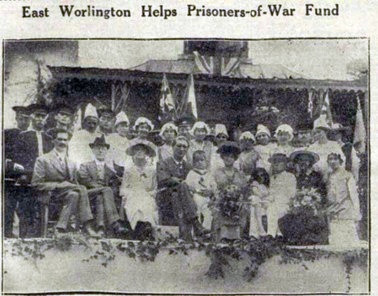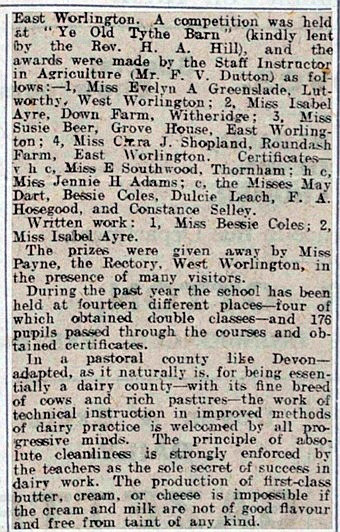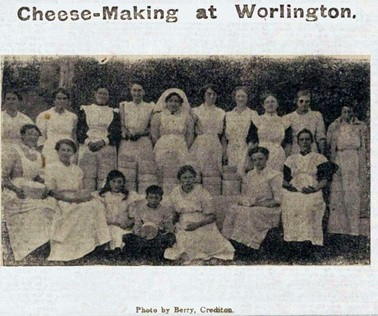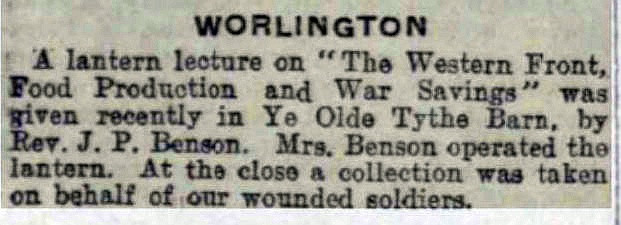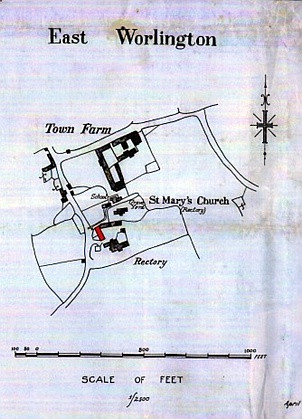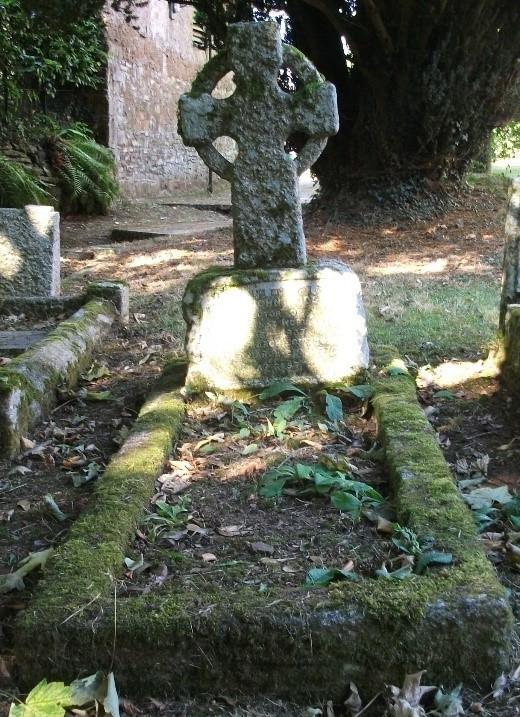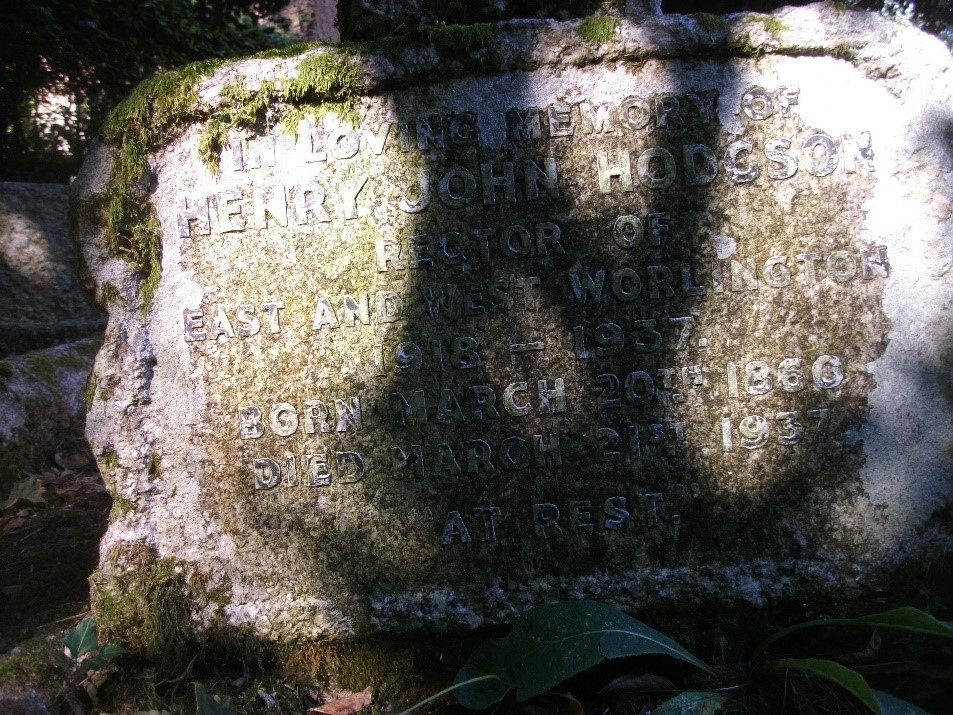The Rector of East Worlington in 1920 was the Reverend Henry John Hodgson, who became incumbent of the parish in 1919. While the barn was sold as a Parish Hall in 1920 there is evidence that the Hall was used for community purposes before 1920.
Prior to 1920 – Reverend Horace Ayton Hill
The rector prior to Reverend Hodgson was the Reverend Horace Ayton Hill, who became rector of the ecclesiastical parish of St Mary, East Worlington in 1891 and of St Mary, West Worlington in 1902.
In 1885 the parish of West Worlington was merged, for civic administrative purposes, into the neighbouring small parish of East Worlington, and in 1919 it was merged into the ecclesiastical parish of East Worlington to form a single ecclesiastical parish. (reference: Welcome to the Churches of Worlington. Pamphlet produced by Ralph N May 1978 with second edition with amendments 1986)
|
It appears that Reverend Hill took up residency in the Rectory in West Worlington. Evidence supporting this assumption is drawn from the fact he is buried in West Worlington graveyard and that an event reported in the Western Times on 10th August 1917 in support the Prisoner of War fund was held in the garden of West Worlington Rectory in 1917. There is photographic evidence and the commentary in the article states, ‘It was surprising what a variety of attractions had been collected on the Rectory lawn, and the activity and enthusiasm of the helpers that the Rev. H. A. Hill had gathered round him were beyond praise.’ Various newspaper articles indicate he was a well-travelled man, being ordained by the Bishop of Chester in 1880, having studied at Exeter College, Oxford and taking up his first parish duties at St John the Baptist Church in Bollington, near Mansfield. It is reported he left that appointment in 1884. |
The Rectory at West Worlington |
The Lake’s Falmouth Packet and Cornwall Advertiser 27th October 1888 reports he was curate in St Mawes, Cornwall from about 1886 and in 1888 had recently moved as Curate-in-Charge of Golant, nr Fowey. The article also reports his marriage to a Mrs Caroline Payne, the widow of the late Dr. W. O. Payne, at the parish church of St. Just-in-Roseland. The bride was attended by her little daughter.
The Exeter and Plymouth Gazette 3rd August 1891 reports Reverend Hill’s appointment to West Worlington in 1891. He retired in 1919 and died in 1939.
His obituary in Western Times 25th June 1939 states, ‘As a minister he was loved by all and was a keen worker amongst his parishioners. For many years he acted a secretary to the Worlington Flower Show.’
These details suggest the Reverend Hill was a strong community minded clergy and while there is no direct evidence of his connection with the barn / Parish Hall while he was rector is was as a part of the East Worlington Rectory property was in church ownership and within his management responsibilities. During the time of his incumbency there are recorded events which confirm the barn was used for community purposes.
|
The Devon and Exeter Gazette in 1909 reported on Cheese Making at Worlington and naming Reverend Hill as kindly lending ‘Ye Old Tythe Barn’.
|
In 1916 the newspaper again reported on Cheese Making in Worlington showing a photograph of the group against the hedge adjacent to the building.
|
|
Another event providing evidence that the Parish Hall had community use prior to 1920 was an article that appeared in the Western Times on 26 October 1917 which reported that a lecture on ‘The Western Front, Food Production and War Savings’ had been given by the Rev J P Benson. The article confirms that his wife operated a Lecture or Magic Lantern. |
|
The Henry John Hodgson Era
Reverend Hill retired in 1919 and that started the next phase in the life of the barn / Parish Hall with the new incumbent Reverend Henry John Hodgson.
Selling of the Barn as a Parish Hall
The first evidence we have of Reverend Hodgson shaping the future of the bar / Parish Hall is in an article from Parochial Magazine for the Deanery of Chulmleigh in May 1919.
The context for the action for the building to go into community ownership is described below.
Following World War 1 there was national consensus that those who served and died should be remembered. On a national level the government decided in principle on a national memorial in London which it would pay for. The government made it clear, however, that it would not pay for local war memorials and that these should be the responsibility of local communities. As a result of the informal discussions which ad-hoc groups had been having throughout the country, there was an equally informal blueprint about how to create a local war memorial. This blueprint “emerged” from the public without any government involvement or direction. It was so obviously such a practical and sensible plan that it was followed virtually everywhere, with some differences to take account of local circumstances. The plan had a few basic components:
- In each locality a local war memorial committee should be formed from members of the public. The forum for electing these committees would be a public meeting called for that specific purpose.
- It was the responsibility of these committees to raise the funds necessary to build the war memorials
- It was also their responsibility to decide on the nature of the war memorial preferably after public consultation, and to commission its building
- Each memorial would have a list of the local men who had died when serving with the colours no matter what form the memorial took. This list would be collected by the volunteers on the committee and made available for checking by the public who could thus try to ensure that no one was omitted.
- The committee should draw up a plan for the future maintenance of the memorial.
The article Parochial Magazine for the Deanery of Chulmleigh in May 1919
The meeting in the ‘Old Tithe bar’ to consider what steps should be taken by the parish to provide a suitable War Memorial was well attended. Mr Stucley who was in the chair, referred in feeling terms to those who had given up their lives for King and Country. A discussion then followed, and it was decided that a public memorial of some description should record the names of those who had fallen in the war, and all who served in the Military, Naval and Air Forces.
The following Committee were elected to carry out the scheme:- Mrs G Smyth, Miss Hammond, Miss Murch, Messrs. Adams, Chapple, Cox, Hodgson, Hosegood, Shapland, H. Smyth, Stucley, Troake, and F Webber, with Mr Edmonds as Honorary Secretary and Mr Lake as Honorary Treasurer.
The idea which seemed to find most favour among the audience was the provision of a Memorial Hall, which should be the absolute property of the parish, and in which all kinds of entertainment and meetings could be held. Miss Hammond spoke of the great advantages such a building would confer for entertaining ad amusing the young people in the parish during the winter months. The Rector then explained that in all probability the Old Tithe Barn would be put up for auction in the near future or failing a purchaser would be demolished. It now rests with the Committee to decide whether or not they shall purchase the old building and renovate it.
There is no doubt that the expenditure of, say, £100 or £150 would provide a very fine room as a Memorial Hall, at a fraction of the cost of erecting an entirely new building. Amid much enthusiasm Mr Stucley announced that he would start the ball rolling with a donation of £50.’
The conveyance of the building from church ownership to East Worlington Parish Council ownership was completed in 1920.
|
|
|
Original 1920 Conveyance Document Front Page and Plan |
|
About Henry John Hodgson
Records confirm the Reverend Henry John Hodgson was an interesting character.
Birth
His gravestone in East Worlington church graveyard states his birth was on 20th March 1860 and census records located on the website www.ancestry.co.uk confirm his birth place as Brighton, Sussex to parents John Willaby Hodgson and Julia Hodgson.
Headmaster at St Peter’s School, Exmouth
The record on the St Peter’s School, Exmouth history website page confirms Henry John Hodgson as Headmaster from 1890. Their school website states:
St Peter’s was founded in 1882 by the Rev. Alfred Wren on Boarden Barn, Exmouth, with about a dozen pupils. He took the name from Peterhouse, Cambridge where he was an undergraduate. Upon his retirement in 1890, the school was taken over by Mr Hodgson, who was determined to make the school a success, and was its Headmaster for twenty-three years. He and his wife made considerable improvements to the school during that time. For example, it was the first school in Devon to take up the game of hockey only four years after its introduction to the country. Hodgson grew the school to about thirty pupils before his retirement in 1913.
Cavendish College
Hodgson had attended and graduated from Cavendish College, Oxford an institution itself of historical interest.
Cavendish College was the product of the enterprise of the Norfolk clergyman, Joseph Lloyd Brereton, who aspired to enable those of poorer means to achieve a university education. By the 1870s Brereton had a plan to create colleges in the old universities of Oxford and Cambridge that would provide a stepping stone to academic achievement for boys who could not hope to afford a traditional university career. His idea was that students could enter these colleges aged 15, then reside in the new colleges for a year working for a certificate called a ‘County Degree’. If they stayed longer they could take a B.A. aged 19 or 20, two years younger than normal. From this pool of qualified young men he hoped to be able to recruit a new generation of secondary school teachers.
A temporary college for a handful of students was opened in 1873 in Norwich House, Panton Street. In 1877 the college moved to its permanent buildings on ten acres off Hills Road bought from Trinity College.
Brereton was a poor financial manager and the college was in difficulties from the start, in particular because it never attracted the 300 students its financial viability was based upon. These students were charged £84 per year. But insufficient capital was raised for the project and accommodation was only provided for 100.
The wardens of Cavendish were not effective managers. John Cox was warden for ten years, but he was a poor administrator and when the college affairs hit crisis point in 1887 he resigned.
Cavendish was not a proper college; in the eyes of the University it was a lodging house for non-collegiate students. Cavendish students were undergraduates, often younger that those at proper colleges, but not as young as envisaged by Brereton originally.
The evidence of the background of the Cavendish students is patchy but it appears that most came from professional families and therefore not so different from some colleges such as Peterhouse which had a far smaller proportion of students from the leading public schools compared with colleges such as Trinity.
However, the college failed to attract enough students or investors. Cavendish College closed in 1892 and was sold to Homerton College in 1894.
(Sources: Proceedings of the Cambridge Antiquarian Society)
This suggests that Hodgson must have attended at some time between 1873 (College opened) and 1890 (appointment to Headteacher at St Peter’s School, but unlikely a direct appointment from graduating).
Mother’s Death 1903
Information supporting that Hodgson was living in Exmouth in the early 1900s was provided by the Dorking and Leatherhead Advertiser on 19th September 1903 which reported the death on the 4th May 1903 of Julia Hodgson (his mother) (widow) who was living in Elmscroft, Redhill, Surrey. Henry John Hodgson of St Peter’s Exmouth was named as one of the executors of her will.
Ordination
The Exeter and Plymouth Gazette 11th June 1906 reported that In the Ordination Service held in Exeter Cathedral on 10th June 1906 Hodgson was licensed as curate at Withycombe Raleigh in Exmouth.
In the Western Times 28th May 1907 it was reported that on the ‘previous Sunday’ Henry John Hodgson was admitted to Holy Orders and achieved the status of priest.
The Exeter and Plymouth Gazette 25th October 1913 reported that on 24th October 1913 Henry John Hodgson was licenced by the Bishop of Exeter to be curate of Crediton.
Accident
There was wide spread press coverage of an accident that happened to Reverend Hodgson on 24th December 1913. This extract from the Taunton Courier and Western Advertiser is typical of the newspaper reports as far away as Northern Ireland and Lincolnshire.
For a long time he had used a Boer artillery shell as a door-weight in his sitting room, never supposing it was ‘alive’. He also possessed a sword bayonet for French Manufacture. It seems that Mr Hodgson intended to bend the bayonet and attach it as a crook to the shell. He heated and bent the bayonet, took out the percussion cap, and inserted the end of the hot bayonet in the hole in the shell. The shell immediately exploded with serious effects. Mr Hodgson’s right leg was fractured below the knee his right wrist terribly lacerated, and his face badly burned by the igniting powder. The plate-glass in the French window blown out, most of the furniture in the room was smashed to bits and hole was made in the floor where the shell lay. Fragments of shell were found in different parts of the room and embedded in the walls, the furniture and the garden.
Mr Hodgson was found prostrate and a medical attendant, seeing that the injuries were so serious, ordered the patient’s removal to the Devon and Exeter Hospital, where he was taken in a motor-car. On enquiry at the hospital in the evening it was learned that the rev. gentleman was in a serious condition, but it had not the been decided whether it was desirable to amputate the leg.
While the Reverend Hodgson did recover he was left a cripple for the rest of his life and this was confirmed in his obituary in the press in 1937.
Reverend Hodgson’s Family
Reverend Hodgson had a wife, Alice, Charlotte, Mary, Hodgson nee Sproate and a son born in 1899. At the time of his death in 1937 his son was in Athens. His obituary in the press confirmed they both survived him.
Hobbies, Interests and Contributions
An article in the Western Times 25th March 1937 about his death gave a small insight into his life. It reports that his hobbies were Engineering, and Architecture and he was an expert in Ecclesiastical Architecture. He made several models of churches and castles and old mansions situated in various parts of the country. They were constructed to scale which it is reported must have meant he was a man of great patience and skill. It is comments that he was an amateur carpenter few could equal. He used his own skills to make improvements in both churches. He made numerous sideshows which provided splendid money raisers at his harvest home. All sorts of wonderful contrivances for utility purposes could be seen in his garden. He was editor of the Deanery Magazine for several years and had included within it many articles about all seventeen churches it served. He was a member of the Diocesan Dilapidation Board and was always zealous in helping incumbents who sought his advice about their burdensome parsonages.
Reverend Hodgson’s Use and Support of the Parish Hall 1920 to 1937
The evidence for this comes from the Parish Hall Accounts book with entries between 1921 and 1937. Reverend Hodgson may indeed have offered more support in different ways than the records of hall hire shows but the dates and types of events indicate some of his work in the parish. The following chart provides the information extracted from the handwritten and sometimes vague entries about hire and income.
| Year | Date | Entry Name | Event | Hall Receipt |
| 1921 | Dec-21 | Whist Drive and Dance | £4 / 0s / 0d | |
| 1922 | 16 May 1922 | Dance | £4 / 2s / 6d | |
| 1923 | 6th April 1923 | Mr Hodgson | Dance | £0 /10s / 0d |
| 9th May 1923 | Mr Hodgson | Whist Drive and Dance | £0 /10s / 0d | |
| 27th June 1923 | Mr Hodgson | Dance | £0 /10s / 0d | |
| 1924 | 2nd January 1924 | Mr Hodgson | Choir Supper | £0 /10s / 0d |
| 13th October 1924 | Mr Hodgson | Harvest Tea | £0 /10s / 0d | |
| 1925 | 6th January 1925 | Mr Hodgson | Choir Festival | £0 /10s / 0d |
| 12-Oct-25 | Mr Hodgson | Harvest Tea | £0 /10s / 0d | |
| 1926 | 8th February 1926 | Mr Hodgson | Choir Supper | £0 /10s / 0d |
| 5th April 1926 | Mrs Hodgson | Concert | £0 /10s / 0d | |
| 10th October 1926 | Mr Hodgson | Harvest Tea | £0 /10s / 0d | |
| 1927 | 5th January 1927 | Mr Hodgson | Choir Supper | £0 /10s / 0d |
| 29th April 1927 | Mr Hodgson | Easter Dance | £0 /10s / 0d | |
| 6th July 1927 | Mr Hodgson | Deanery Luncheon | £0 / 2s / 6d | |
| 28th September 1927 | Miss Hammond | Harvest Tea | £0 /10s / 0d | |
| 1928 | 16th January 1928 | Miss Hammond | Choir Supper | £0 /10s / 0d |
| 17th January 1928 | Miss Hammond | Sunday School Treat | £0 / 5s / 0d | |
| 3rd October 1928 | Mr Hodgson | Harvest Tea and Dance | £0 /10s / 0d | |
| 13th December 1928 | Mr Hodgson | Meeting | £0 / 5s / 0d | |
| 1929 | 2nd January 1929 | Mr Hodgson | Choir Dance | £0 /10s / 0d |
| 26th September 1929 | Mr Hodgson | Harvest Tea and Dance | £0 /10s / 0d | |
| 1930 | 15th January 1930 | Mr Hodgson | Lady Stucley Party | £0 / 5s / 0d |
| 16th January 1930 | Mr Hodgson | Choir Supper | £0 /10s / 0d | |
| 21st March 1930 | Mr Hodgson | Dance | £0 /10s / 0d | |
| 6th April 1930 | Mr Hodgson | Easter Dance | £0 /10s / 0d | |
| 14th October 1930 | Mr Hodgson | Harvest Tea | £0 /10s / 0d | |
| 1931 | 7th January 1931 | Mr Hodgson | Choir Supper | £0 /10s / 0d |
| 9th April 1931 | Mr Hodgson | Easter Dance | £0 /10s / 0d | |
| 1932 | 8th January 1932 | Mr Hodgson | Choir Supper | £0 /10s / 0d |
| 13th January 1932 | Mr Hodgson | Lady Stucley Treat | £0 / 5s / 0d | |
| 7th April 1932 | Mr Hodgson | Whist Drive and Dance | £0 /10s / 0d | |
| 28th May 1932 | Mr Hodgson | Tea | £0 / 5s / 0d | |
| 29th September 1932 | Mr Hodgson | Harvest Tea | £0 /10s / 0d | |
| 1933 | 9th January 1933 | Mr Hodgson | Lady Stucley Treat | £0 / 5s / 0d |
| 16th January 1933 | Mr Hodgson | Choir and Ringers Supper | £0 /10s / 0d | |
| 15th February 1933 | Mr Hodgson | Donation towards repair of Hall | £5 / 0s / 0d | |
| 5th April 1933 | Mr Hodgson | Use of Hall | £0 / 5s / 0d | |
| 26th July 1933 | Mr Hodgson | Whist Drive | £0 / 5s / 0d | |
| 16th October 1933 | Mr Hodgson | Harvest Tea | £0 / 12s / 6d | |
| 1934 | 17th January 1934 | Mr Hodgson | Choir Supper | £0 / 5s / 0d |
| 2nd February 1934 | Mr Hodgson | Gift to Hall | £5 / 0s / 0d | |
| 19th April 1934 | Mr Hodgson | Use of Hall | £0 / 5s / 0d | |
| No date provided | Mr Hodgson | Whitsun Dance | £0 /10s / 0d | |
| No date provided | Mr Hodgson | Harvest Tea and Dance | £0 /10s / 0d | |
| 1935 | 5th April 1935 | Mr Hodgson | Jumble Sale | £0 /10s / 0d |
| No date provided | Mr Hodgson | Use of All for Tea | £0 /10s / 0d | |
| No date provided | Mr Hodgson | School Treat | £0 / 5s / 0d | |
| No date provided | Mr Hodgson | Choir Supper | £0 /10s / 0d | |
| 1936 | 5th October 1936 | Reverend Hodgson | Hire of Hall | £0 /10s / 0d |
| 1937 | 12th January 1937 | Mr Hodgson | Hire of Hall | £0 /10s / 0d |
| The image shows one page in the Parish Hall Accounts Book. The financial year is 1932/1933 and it shows some of the uses of the Hall at that time. | 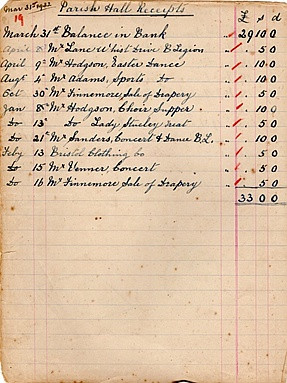 |
Death of Reverend Henry John Hodgson
Reverend Hodgson passed away on the morning of Sunday 21st March 1937 at the East Worlington Rectory. He left an estate of gross value £2,154 / 16s / 8d and a net personalty of £2,046 / 13s / 0d.
|
|
|
He was buried in East Worlington graveyard and his tombstone remains to remind us of his place and importance in the history of the Parish Hall and the community more generally.
